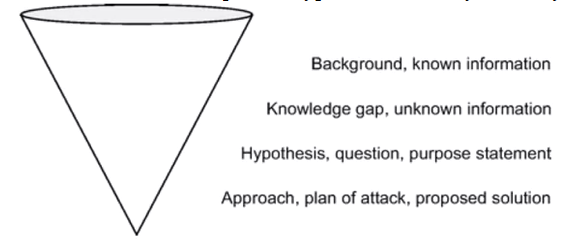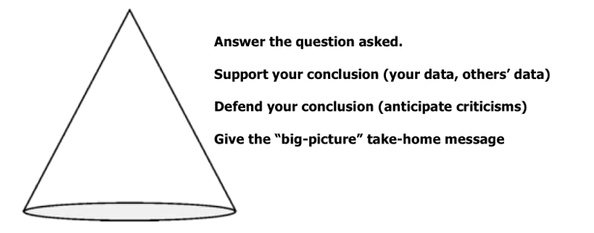科学论文写作 Tips
1 Steps in the Writing Process
如何开展论文写作以及各个步骤的时间分配
Prewriting (70%)
- 收集,综合与组织信息
- 头脑风暴一下本文的 take-home messages
- 脱离电脑来思考
- 写出一个逻辑图或大纲 (roadmap or outline)
Writing the first draft (10%)
- Putting your facts and ideas together in organized prose
这部分被普遍认为是最难的一个部分。然而,老师却建议使用最少的时间进行第一版的写作。我个人觉得,这和吴恩达老师建议机器学习模型很一致,先在能表达清楚的基础上,构建一个基本的框架模型。不管它多 low,毕竟第一次就想要达到最完美的效果是不可能的。
Revision (20%)
- 大声朗读文章
我的导师也给过我这个建议,有时候确实朗读会比默读发现更多的问题 - 去掉杂乱的部分
- 动词检查
- 把每一句的主要动词都画上下划线,来寻找: 1) lackluster verbs; 2) passive verbs; 3) buried verbs
- Cut verbs. Watch for: 1) Dead weight words and phrases (e.g. It should be emphasized that); 2) Empty words and phrases (e.g. basic tenets of, important); 3) Long words or phrases that could be short (e.g. muscular and cardiorespiratory performance); 4) Unnecessary jargon and acronyms; 5) Repetitive words or phrases; 6) Adverbs (e.g. very, really, quite, bascially)
- 从其他人那获取反馈意见
2 终稿的 checklist
- 检查文章的前后一致性
- 检查文章中的数字是否一致
- 摘要中的数字与文章中文字/图表里的数字是否一致?
- 文字中的数字与图表中的是否一致?
- 各个图表中的数字是否一致?
- 检查参考文献
- 参考文献是否提供了语境中想表达的信息
- 是否误读或夸大了原文献中的发现
- 引用的文献是第二手引用(引文的引文)而不是最初的引用
- 参考文献格式 ((author, year) 还是 author (year))
- 参考文献是否提供了语境中想表达的信息
3 推荐的写初稿的步骤
3.1 图表
- 图表应该独立地讲一个完整的故事,使读者不用看文字就能明白
- 图与表格的特点
- 图 (Visual impact, Show trends and patterns, Tell a quick story, Tell the whole story, Highlight a particular result)
- 表 (Give precise values, Display many values/variables)
- 表格标题
- 明确地表明表格想要说明的主题或观点
- 在表格标题,列标题和文章中使用相同的关键术语
- 保持简洁
- 示例: "Descriptive characteristics of the two treatment groups, means\(\pm\)SD or N(%)"
- 表格脚注
- 根据期刊的手册,使用上标来表明脚注
- 使用脚注来解释统计上的显著差别
- 使用脚注来解释实验细节或表格中使用的缩写
- 图的类型
- 折线图 Line Graphs
- 用来表示随时间、年龄、剂量等变换的趋势
- 柱状图 Bar Graphs
- 用来表示不同组在同一时间点的区别
- 散点图 Scatter Plots
- 用来表示两个变量之间的关系(特别是线性相关关系)
- 可以让读者看到所有的单独数据点(也就是更多的信息)
- 折线图 Line Graphs
3.2 Results
- Results \(\ne\) Raw Data
- results 章节应该
- 总结数据表明了什么
- 指出数据中存在的简单关系
- 描述数据趋势
- 使用图表来展示数据
- 避免简单重复阐述已经在图表中展示了的数字
- 总结数据表明了什么
- 撰写 results 章节的建议
- 分成多个带标题的小节
- 补充已经在图表中的信息
- 给出图中没有写出的具体数值
- 如果具体数值已经在表格中给出,那么描述数据的变化与区别
- 只重复或强调最重要的数值
- Don't forget to talk about negative and control results
- 尽量仅在统计学显著时使用单词 "significant"
- 仅在 methods 章节阐述你是怎么做的
- 特别地,不要在这个章节讨论数据分析的基本原理
- 仅在 discussion 章节阐述这些结果说明了什么
- 动词时态
- 使用过去时描述已完成的动作
- We found that …
- The average reaction time was …
- 使用现在时描述一直为真的主张,如 what the tables show, what you believe, and what the data suggest
- Figure 1 shows …
- The findings confirm …
- The data suggest …
- We believe that this shows …
- 使用过去时描述已完成的动作
3.3 Methods
- 给出清晰的本文做了什么的概述
- 给出足够多的信息使得别人可以重复这个研究(我导师的说法是,这部分就是实习报告)
- 分成多个带标题的小节
- 通用的方法需要引用文献
- 动词时态
- 阐述方法用过去时 ("we measured")
- 使用现在时来描述数据 ("data are summarized as means\(\pm\)SD")
3.4 Introduction
- 遵循标准的格式
- 一般来说是 3 个段落的长度 (推荐的区间是: 2 到 5)
- 它不用是一个这个领域的详细全面综述
- 应用聚焦于本文特定的假设或研究目标

- What's known (Paragraph 1)
- What's unknown (Paragraph 2)
- Limitations and gaps in previous studies
- Your burning question/hypothesis/aim (Paragraph 3)
- Your experimental approach (Paragraph 3)
- Why your experimental approach is new and different and important (fills in the gaps) (Paragraph 3)
- 撰写 Introduction 的建议
- 保持段落简短
- 写给一般普通的读者看(清晰,简练,不要太专业)
- 建立逻辑流,引导读者一步一步地从已知到未知再到本文特定的研究问题(Known→Unknown→Question/hypothesis)
- 强调本文是如何解决当前研究中的 gaps (the unknown) 的
- 在一个很高的层次来总结 Summarize at a high level! 把具体的描述,推断和特定研究的批评留在 discussion 章节。
3.5 Discussion

What do my results mean and why should anyone care?
A example framework

- 撰写 discussion 章节的建议
- Showcase good writing!
- Use the active voice
- Tell it like a story
- Start and end with the main finding
- "We found that …"
- Don't travel too far from your data
- Focus on what your data do prove, not what you had hoped your data would prove
- 聚焦于重要的 limitations,而不是一般的 limitations
- 确保本文的 take-home message 是明确清楚且一致的
- Showcase good writing!
- 动词时态
- 过去时,当引用研究的细节,结论和分析时和引用其他研究时
- We found that
- Subjects may have experienced
- Miller et al. found
- 现在时,当讨论本文的数据时
- The greater weight loss suggests
- The explanation for this difference is not clear
- Potential explanations include
- 过去时,当引用研究的细节,结论和分析时和引用其他研究时
3.6 Abstract
- 对于本文想讲的主要故事的概述
- 给出本文中每个章节的重点
- 注意长度 (100-300 words, typically)
- 框架
- 背景 (1 句话)
- 给予读者本文的研究背景,它能强调本文的重要性
- 本文的目标或研究问题或假设
- "We asked whether" "We hypothesized that" … etc
- 本文的实验描述
- Quick summary of key materials and methods
- 结果
- 主要的结果发现
- Minimal raw data (prefer summaries)
- 结论
- 对于研究问题的回答或者是 take-home message
- 本文的启示,推断或者意义等
- 背景 (1 句话)
4 Peer Review
4.1 Process
- Scan the abstract
- Jump to the data: review the tables and figures first
- Draw your own conclusions
- Do the tables and figures stand on their own?
- Are there any obvious statistical errors?
- Is there repetitive information?
- Read the paper once through
- Do the authors conclusions match their data?
- Is the paper clearly written, or did you struggle to get through it? You should not have to struggle!
- Is the length of the paper justified given the amount of new information that the data provide?
- Read the introduction carefully
- Is it sufficiently succinct?
- Does it roughly follow: known --> unknown --> research question/hypothesis?
- Is there a clear statement of the hypotheses or aim of the study?
- Is there detailed information about what was done that belongs in the methods?
- Is there information about what was found that belongs in results?
- Is there distracting information about previous studies or mechanisms that are not directly relevant to the hypothesis being tested. If so, it should be moved to the discussion.
- Do the authors tell you what gaps in the literature they are trying to fill in?
- Read the methods carefully
- Scan this section to find answers to your questions about the data.
- Were things measured objectively or subjectively? What instruments were used?
- Are there flaws in the study design, such as no control group?
- Read the statistics section carefully.
- Read the results carefully
- Read this section with the tables and figures in front of you.
- Does each section roughly correspond to one table or figure?
- Do the authors summarize the main trends and themes from the table, or do they just repeat what is in the tables?
- If there are graphs, do the authors give precise numerical values in the text if it is not given in the graph?
- Are the authors honest or do they try to draw your eye to what they want you to see?
- Do the authors over-interpret statistical significance, by ignoring the fact that the magnitude is small or by ignoring the fact that they have done multiple subgroup analyses?
- Is this section unnecessarily long?
- Look at each table and figure
- Did the authors choose the correct statistics?
- Are there multiple tables or figures that tell the same story?
- Is there evidence of cherry-picking or purposefully omitting data?
- Are any graphs misleading, e.g. through manipulation of area or axes?
- Is the "treatment" group always compared with a proper control/placebo group?
- Are there inconsistencies in the data they present from one table to the next?
- Did the authors make transcribing errors when going from the data in tables/results to the abstract?
- Read the discussion carefully
- Does the first paragraph succinctly and clearly tell you what was found and what is new?
- Are the authors' conclusions justified or are they overreaching?
- Do they clearly distinguish hypothesis-driven conclusions and exploratory conclusions?
- Is the writing clear and to the point (active voice!)? Is there some sense of order and structure or are they just rambling on aimlessly?
- Could the discussion be shortened?
- Did they address the limitations you care about? (as opposed to any old irrelevant limitations that they threw in just to have some)
- Are the references that they cite current?
- Have they omitted key references?
4.2 Content (comments to authors)
- Start with a one-paragraph "general overview"
- State what you think is the major finding and importance of the work
- Give 2-3 positive, encouraging statements about the work. If the methods are problematic, is the writing nice, for example? Is the research question particularly interesting or novel? (E.g., "This is an interesting manuscript, with several strengths." "The authors should be commended for .." "The finding that XX is important.)
- State 1-2 major limitations (if there are any) to the study design, writing/presentation, or conclusions. (E.g., "The study is limited because there is no control group." "The overall writing or presentation need improvement." "The authors may have over-stated their findings." "The paper provides only weak evidence for its conclusions." "The study is exploratory, not hypothesis-driven.")
- Do not tell the authors your overall recommendation (rejection, acceptance)
- In a numbered list, give 5-15 specific criticisms/suggestions for revision. The number will often correspond to your recommendation (give the most if you are recommending "opportunity for revision.")
- Point out specific mistakes
- List the issues that you found in your review
- Give specific recommendations for revision
4.3 Reviewer is not Copy Editor!
- Do not be spend your time nit-picking
- Focus on big-picture issues
- If the manuscript has a lot of copy-editing errors, point this out in a general way and give one or two examples, e.g. "The manuscript contains typos, such as …"
4.4 Content (comments to editors)
- Fill out journal "grading sheet" (if applicable)
- Choose your recommendation
- Reject
- Reject with opportunity to revise
- Accept with minor revisions
- Accept
- Give a succinct overall statement to the editors that justifies your ranking. Be frank with the editors about your opinion and concerns.
5 Review articles: structure
- Abstract
- Introduction
- Clearly state the aim of the review
- The body of the paper
- Divide into sections
- Summarize the literature, organized based on methodology or theme
- Analyze, interpret, critique, and synthesize studies
- Conclusion and future directions
- What recommendations can you make?
- What gaps remain in the literature? What future studies would help fill in these gaps?
- Literature cited
6 A few grammar tips
" Data are" not " Data is" …
The word "data" is plural.
ex: These data show an unusual trend.
ex: The data support the conclusion.
ex: The data are critical.
(v. datum, singular form)
Affect vs. effect
- Affect is the verb "to influence"
- The class affected her.
- As a noun, affect denotes feeling or emotion shown by facial expression or body language, as in "The soldiers seen on television had been carefully chosen for blandness of affect" (Norman Mailer).
- Effect is the noun form of this fluence
- The class had an effect on her.
- As a verb, effect means to bring about or to cause.
Compared to vs. compared with
Compare to = to point out similarities between different things
Compare with ** (used more often in science) = to point out differences between similar things
ex: "Shall I compare thee to a summer's day?"
ex: Brain tumors are relatively rare compared with more common cancers, such as those of the lung, breast.
That vs. which
"That" is the restrictive (defining) pronoun
"Which" is the nonrestrictive (non-defining) pronoun
ex: The vial that contained her RNA was lost.
ex: The vial, which contained her RNA, was lost.
- Key question: Is your clause essential or non-essential?
- THAT: The essential clause cannot be eliminated without changing the meaning of the sentence.
- WHICH: The non-essential clause can be eliminated without altering the basic meaning of the sentence (and muse be set off by commas).
ex: The bike that is broken is in the garage. (Identifies which bike of many)
ex: The bike, which is broken, is in the garage. (Adds a fact about the only bike in question)
Singular antecedents
Do not use "they" or "their" when the subject is singular. To avoid gender choice, turn to a plural!
ex: Each student worries about their grade. (wrong!)
ex: Each student worries about her grade. (wrong!)
Better: All students worry about their grades.


